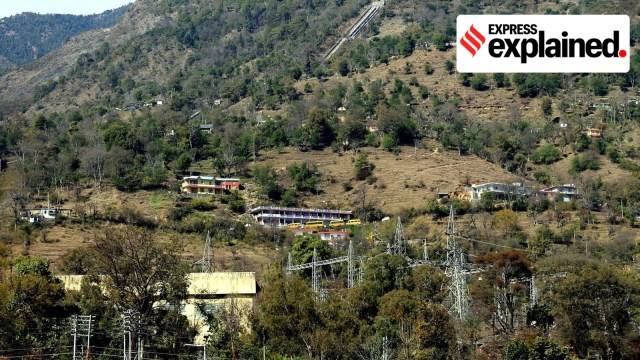Haryana has added a new dimension to the ongoing legal dispute between Himachal Pradesh and Punjab over the British-era 110 MW Shanan Hydel Project by filing a petition in the Supreme Court. Haryana has requested to be made a party to the case. Experts believe this is an unprecedented move by Haryana, a state that was part of undivided Punjab, like Himachal Pradesh, before 1966, seeking to have its voice heard in the matter.

The Shanan Hydel Project, which is located in Jogindernagar, Mandi, was leased to Punjab in 1925 for 99 years. The lease agreement was signed between the then ruler of Mandi, Raja Joginder Bahadur, and Colonel B C Batty, a British representative and Chief Engineer of Punjab.
Before Independence, the project supplied electricity to undivided Punjab, Lahore, and Delhi. After Partition, electricity supply to Lahore was discontinued, and the transmission line was terminated at Verka village in Amritsar.
Initially designed as a 48 MW project, the Shanan Project was later upgraded to 60 MW and eventually 110 MW by Punjab to meet its growing electricity demands. Under the current lease terms, the project also provides Himachal Pradesh with 500 kW of free electricity as it draws water from the Uhl river, which is located in the state.
Why was Punjab given the control of the project after its reorganisation?
Following the reorganisation of Punjab in 1966, the Shanan Hydel Project was allocated to Punjab as Himachal Pradesh was a Union Territory at the time. A notification issued by the Ministry of Irrigation and Power on May 1, 1967, granted Punjab legal control over the project under the Punjab Reorganisation Act, 1966.
However, after the project’s lease expired on March 2, 2024, Himachal Pradesh Chief Minister Sukhvinder Sukhu firmly stated that Punjab cannot claim the project. Himachal Pradesh has alleged that the project has been poorly maintained by Punjab as it has neglected repair work.
What has Punjab said in SC?
Story continues below this ad
On September 20, Punjab filed a petition in the SC seeking a permanent injunction to prevent Himachal Pradesh from interfering with the Shanan Hydel Project’s possession and operations. Punjab’s civil suit asserts that the project is managed by the Punjab State Power Corporation Limited (formerly the Punjab State Electricity Board) and was legally allocated to Punjab under the 1967 notification. Punjab also requested a temporary injunction to maintain the status quo.
What has Himachal Pradesh argued in SC?
In response to Punjab’s civil suit, Himachal Pradesh filed a petition, urging the SC to dismiss Punjab’s claims. Himachal Pradesh argued that the case’s foundation is based on a pre-Constitution agreement and the dispute does not fall under the SC’s jurisdiction as per Article 131 of the Constitution.
Article 131 gives the SC the exclusive right to handle disputes involving the government of India and one or more states, government of India and some states on one side and one or more other states on the other, two or more states, if the issue involves a legal right. Only the SC can hear these cases; no other court has this authority. However, the Constitution bars the jurisdiction of the SC over interstate river water disputes.
Article 262 states that Parliament can make a law for the adjudication of any dispute regarding the use, distribution or control of the waters of, or in, any inter-State river or river valley. These disputes are governed by the Interstate River Water Disputes Act 1956. Under this law, a water Disputes Tribunal is set up for the adjudication. However, the SC, for the enforcement of such tribunal awards or in appeal against the tribunal’s decision, has intervened in several interstate river water disputes.
Story continues below this ad
Himachal Pradesh has also highlighted that the 1925 agreement was between the British government and the Raja of Mandi, and the Mandi State was never part of Punjab.
What was the central government’s response?
On March 1, 2024, a day before the lease expired, the Ministry of Power ordered the status quo to be maintained regarding the Shanan Project as an interim measure. The order stated that this was to ensure the project’s continued operation and avoid disruptions. The ministry clarified that the order does not establish any claims or interests and encouraged the parties to resolve the dispute through appropriate legal channels.
Why has Haryana filed an application?
In its application submitted on December 12, Haryana argued that the Shanan project, located on the Uhl River— a tributary of the Beas — also feeds the Bhakra Dam. As Haryana has a stake in the Bhakra Beas Management Board (BBMB), it contends that it has a legitimate claim to the project. Haryana’s application also cites the Punjab Reorganisation Act, 1966, asserting its historical connection as a part of undivided Punjab.
Story continues below this ad
Himachal Pradesh Advocate General Anup Kumar Rattan said that Himachal Pradesh would oppose Haryana’s application, asserting that the matter is primarily between Punjab and Himachal Pradesh. Punjab is also expected to oppose Haryana’s move. Himachal Pradesh plans to file its objection during the Supreme Court hearing scheduled for January 15, 2025.








































